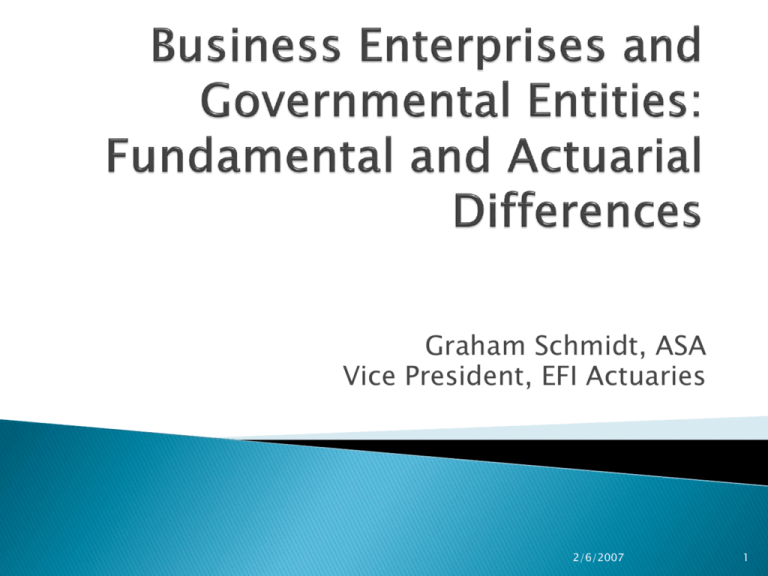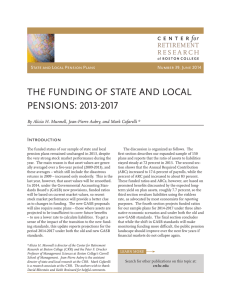Fundamental and Actuarial Differences
advertisement

Graham Schmidt, ASA Vice President, EFI Actuaries 2/6/2007 1 Fundamental Differences ◦ ◦ ◦ ◦ Purposes Revenue Budget obligations Longevity Actuarial Differences ◦ Private sector requirements (FASB / PBGC / IRS) ◦ Governmental approaches (level cost, transfers, funding rules) ◦ Public vs. private 2/6/2007 2 “Why Governmental Accounting and Financial Reporting is – and should be – different” – GASB White Paper 2/6/2007 3 Purpose ◦ For-Profit Business Enterprise: Generate a financial return on investment ◦ Government: “Focus on providing services and goods to constituents in an efficient, effective, economical and sustainable manner.” Revenue ◦ For Taxpayer, amount of taxes paid does NOT bear direct relationship to services received Budget Obligations 2/6/2007 4 Longevity ◦ Number of municipal bankruptcy filings 0.02% of business filings ◦ Long-term outlook leads to focus on “trends in operations, rather than on short-term fluctuations, such as in fair values of certain assets and liabilities.” Short-term fluctuations result in less “decision-useful” measurements For businesses, short-term more important because of current value of equity 2/6/2007 5 Methods, Measurements and Other Issues 2/6/2007 6 Accounting ◦ Governed by FASB (FAS 87, 106, 132 & 158) ◦ Measure Projected Benefit Obligation (PBO) Based on Projected Unit Credit actuarial funding method Prescribed to improve comparability, but mismatch between accounting/funding ◦ Rate used to discount liabilities based on “settlement rates” based on annuity rates or high-quality fixed income average ~ 5.5–6.0% in FY 05 can be quite variable from year-to-year 2/6/2007 7 Accounting Continued ◦ Use different rate for “expected return on assets” used to calculate reported pension expense average ~ 8.0-8.5% in FY 05 may change due to future FASB projects ◦ Amortization / Smoothing Most elements amortized over average remaining service of current actives Only have to amortize portion of g/l Max smoothing period for assets is 5 years 2/6/2007 8 Funding ◦ Basis Companies offer “qualified” plans to obtain tax advantages IRS makes rules to ensure funding status (protect PBGC and participants) and ensure “fairness” (nondiscrimination, etc) Rules define minimum / maximum contributions Pension Protection Act (PPA) changed rules significantly 2/6/2007 9 Funding (new rules) ◦ PPA defines “Funding Target” – 100% of PV of accrued benefits (was 90%) [using Unit Credit method] ◦ Unfunded liability must be amortized over 7 years ◦ Discounting based on yield curve (different rates for different payment durations) ◦ Mortality rates dictated by IRS (very large plans can use own experience) 2/6/2007 10 Funding ◦ Max asset smoothing is 24 months, with 10% corridor ◦ Plans with low funding levels (“At-Risk Plans”) subject to additional restrictions / requirements: Contributions Benefit improvements / changes Forms of payment (no lump sums) ◦ PPA also increased maximum contribution limits ◦ Changes to multi-employer rules not as significant 2/6/2007 11 Not one-size-fits-all ◦ Governmental plans not subject to most of ERISA rules ◦ More difficult for IRS to enforce through tax policy ◦ No Federal restrictions on funding (occurs at State or Local level) ◦ GASB defines accounting standards (GASB 25, 27, 43, 45) - contain more flexibility than FASB (funding methods, amortization, etc) 2/6/2007 12 General Actuarial Characteristics ◦ Funding Methods Most pre-fund Cost methods split cost into past costs (accrued liability), current year’s cost (normal/service cost), future normal costs Most common method is Entry Age Normal Goal is to determine level normal cost needed to fund each individual’s benefit GASB allows 6 methods Proposed GASB change: if use Aggregate method, must show funding ratio using EAN 2/6/2007 13 General Actuarial Characteristics ◦ Amortization / Smoothing Most amortize unfunded accrued liability (UAL) Again, no federal rules, but GASB has some restrictions Max period 30 years, level $ or % of pay, open or closed period With long period and level % of pay, current payment may be less than interest on UAL Assets generally smoothed Most common to use 3-5 years (CalPERS using 15) ◦ Discount Rate Generally use expected return on assets Most common: 8.0% in ‘05 (NASRA survey) 2/6/2007 14 Private sector moving towards discounting liabilities at market rates (yield curve) ◦ Influenced by “Financial Economics” Price of liability is asset consisting of matching cashflows (use yield curve) “Mark-to-Market” liabilities $1 of bond = $1 of stock: why would value of liabilities be different? Discounting of liabilities at 8% anticipates “risk premium” -> transfers risk to future generations Existence of PBGC has introduced moral hazard – encouraging investment in overly-risky portfolios 2/6/2007 15 Why important for Private Sector? ◦ Value of equity/debt important (companies bought & sold) ◦ Earnings and contributions (accounting and funding) directly impacted by fluctuations in interest rates because of FASB / IRS rules Large penalties for missing earning targets ◦ Liability-Driven Investing (LDI) attempts to reduce volatility due to interest rate risk by taking into account payment structure of liabilities ◦ Generally results in increased allocation to longduration bonds 2/6/2007 16 Why could be different for governments? ◦ GASB: “Information on fair values of capital assets is of limited value” (less likelihood of bankruptcy / termination) ◦ In current practice (accounting & funding), fluctuations in interest rates do NOT impact government plans Do you measure it? Does measurement matter? ◦ Assuming plans invest in “risky” assets, current practice does better job determining level contributions 2/6/2007 17 Issues with current practice for governments ◦ Discounting at expected rate of return (8%) does not reflect risk of investing ◦ Could measure/contribute using risk-free rate and invest in “matching” portfolio However, certainty has cost! Remember purpose: “providing services and goods to constituents in an efficient, effective, economical and sustainable manner” ◦ Alternatively, could project future asset returns / cashflows (including impact of uncertain inflation) using simulation or other methods Shifts emphasis from liabilities to range of future costs 2/6/2007 18 Smoothing / Amortization ◦ Financial Economics approach says smoothing disguises volatility: “When followed by a corporate bankruptcy, this policy of ignoring economic reality and failing to make needed contributions can lead to devastating losses of retirement income for long-serving employees” – Bradley Belt ◦ With reduced likelihood of bankruptcy / termination in public sector, does argument against still hold? May cause some shifts in cost between generations, but overall contribution level does not change and is more stable 2/6/2007 19 Likelihood of Change? ◦ If government plans forced to measure interest rate volatility (and measurement matters), then changes to investments may result ◦ Important users of financial statements (bondrating agencies) are not currently demanding changes Ability to meet cashflow future requirements more important than consideration of “economic” value of plan ◦ Series of high-profile municipal bankruptcies could prompt demand for funding rules (PBGC-type entity?) 2/6/2007 20





